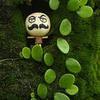A few minutes before 10AM
I enter Kintetsu Nara Station and scan the faces to see if I can spot the female guide whose photo I had seen on the internet. I don't. I walk into the Tourist Information Center and inquire. They point me outside, anywhere outside the Tourist Information Center, is the meeting place. Maybe I am just too early.
A few minutes of standing around and scanning faces, a familiar looking woman hurries to where I am standing, asks if I am here for the tour and apologizes for being late; she is Yoshiko Hatcho, the guide. Another Japanese woman joins us, she is here for the tour, too. We wait a minute or two more and no one else comes along. And so we start our Naramachi Walking Tour. (Woohoo! Just two guests—it is like a private tour!)
Outside the station we stop outside a fountain with a statue of Gyogi Bosatsu, a Buddhist monk who had many contributions to Japan not only in religion but also in civil works. In front of this statue monk was a real monk that seemed like a statue: standing silent and unmoving. The living, breathing statue monk is there every day with his little pot for alms, so the guide tells me.
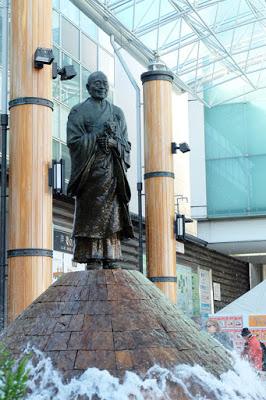
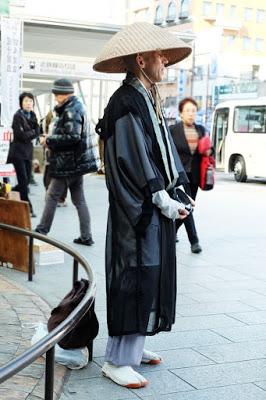
We leave the two monks behind and walk in an alley beside the station where the guide points to a display of sushi wrapped in persimmon leaf—kakinoha-zushi, a specialty in Nara. I want to try a piece, but it is sold by box, so no can do. As we walk along, Yoshiko sees some shops displaying food and tells me about seasonal specialties (such as persimmons for autumn). She also sees a small altar tucked along an alley and tells me about Japan's religions: Shinto and Buddhism.
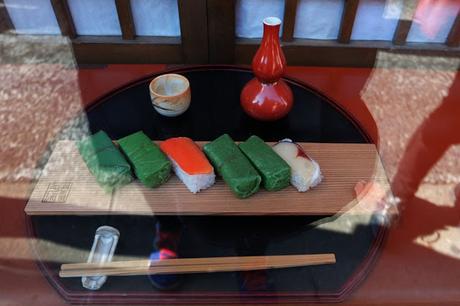 Plastic kakinoha-zushi on display
Plastic kakinoha-zushi on displayWe reach Kofukuji, or at least the oldest structure in the temple complex: its three-storey pagoda. She tells me Kofukuji also has a five-storey pagoda, the second tallest pagoda in Japan, and that we will see it later. Near the three-storey pagoda, we observe some people pouring water over and praying to Jizo, the guardian of children and travelers.
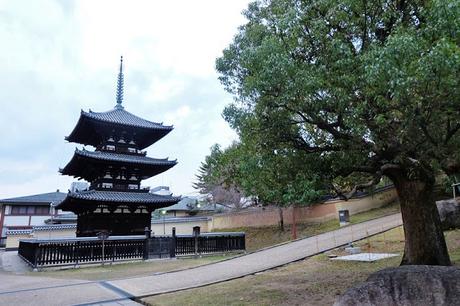 Kofukuji's three-storey pagoda
Kofukuji's three-storey pagoda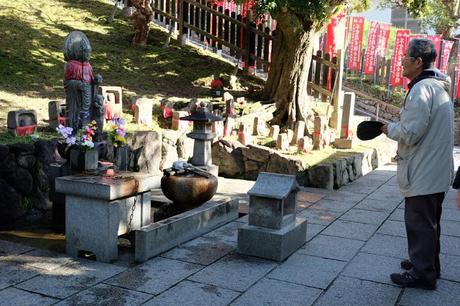 Praying to Jizo
Praying to JizoWe leave Kofukuji, descend some concrete steps and cross the street to Sarusawa Pond, where, from across the pond, I can see Kofukuji's five-storey pagoda jutting behind some trees. We admire the reflections on the pond as Yoshiko tells us about the local life, and then we go southward to the houses and shops of the historic town, Naramachi.
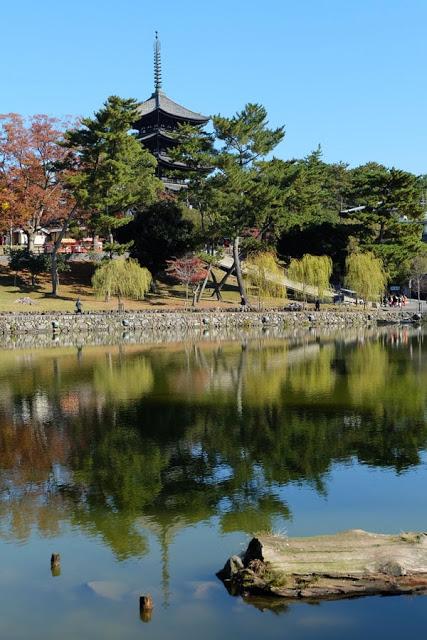 Sarusawa Pond with Kofukuji's five-storey pagoda on the background
Sarusawa Pond with Kofukuji's five-storey pagoda on the backgroundThe streets of Naramachi are deserted. We see narrow houses side by side by side, along narrow streets. Yoshiko points to some details on the houses that I would otherwise have overlooked: the wooden nameplates by the doors and the fierce looking guardians sitting on rooftops to ward away evil spirits.
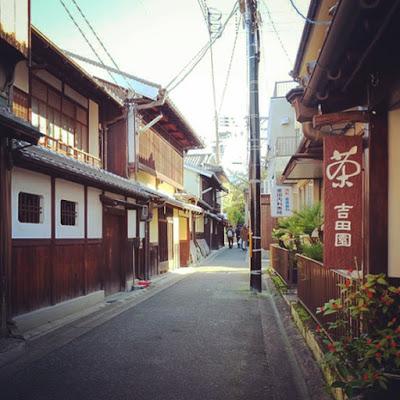 Naramachi
Naramachi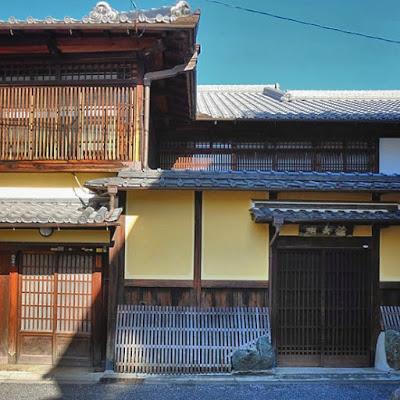 Side by side
Side by side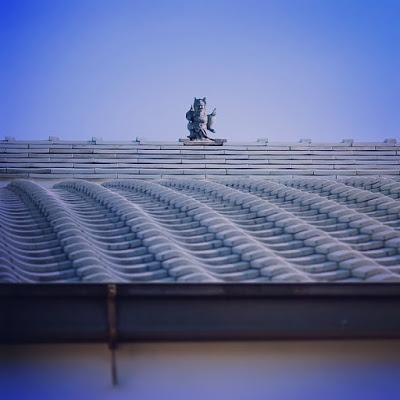 Shoo away, evil spirits!
Shoo away, evil spirits!The guide also tells us about the one thing that I did notice hanging by the door of many houses: red ball like things made of cloth. These are called migawari-zaru; migawari means substitute, and zaru means monkey in Japanese. Each ball a good luck charm for each family member.
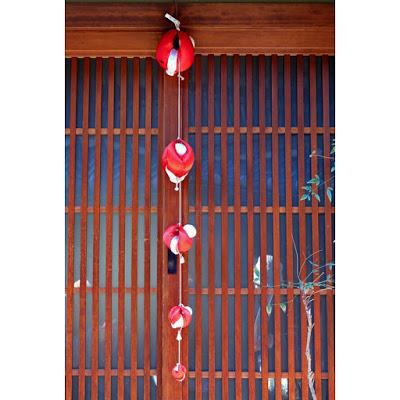 Migawari-zaru
Migawari-zaruWe also see many interesting houses, shops, geisha houses and ochaya (tea house where geishas entertain the patrons), houses that have been turned into cafes or restaurants, an old and very popular tea shop called Tamura Seihoen (open 10AM to 5PM; closed on Wednesdays), and Naramachi's oldest pharmacy called Kikuoka which sells traditional medicine.
 Shops and cafes
Shops and cafes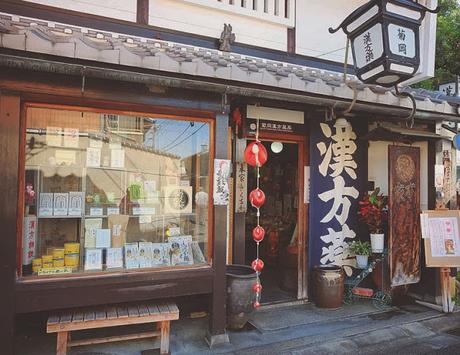 Kikuoka Traditional Pharmacy
Kikuoka Traditional PharmacyYoshiko points to a simple looking establishment—Teahouse Tsuruya, an ochaya that serves lunch! I want to try it, but it is too expensive and reservation is probably needed since they can only accommodate up to 10 persons a day for lunch.
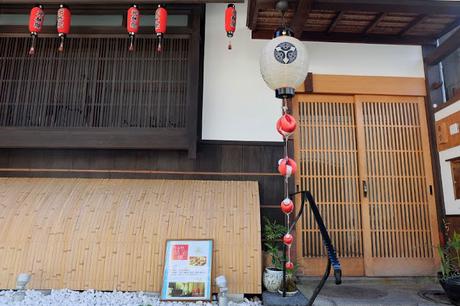 Teahouse Tsuruya
Teahouse TsuruyaWe enter two lattice houses that are open to the public (free admission). One is Nigiwai-no-ie, built in 1917.
Nigiwai-no-ie
にぎわいの家
9AM to 5PM, Closed on Wednesdays
Yoshiko, the guide, opens a small door off to the side of the property and we enter into the garden. We step on the flat stones leading to a tsukubai (wash basin to purify one's self before entering the tea room) and a small low door which leads into a tea ceremony room. Yoshiko tries to open the small door but it is locked and we have to go round to the main entrance. From the outside, the house looks small, but inside it is quite big, with the property stretching towards the back. The narrower the front, the smaller the land tax.
She leads us into the house and shows us the Japanese style rooms with tatami mats and sliding doors, the old kitchen, and the tea ceremony room, where we spend a few minutes as she shows us the elements of a tea room.
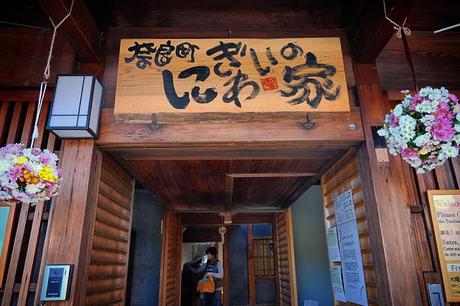 Main entrance of Nigiwai-no-ie
Main entrance of Nigiwai-no-ie Inside Nigiwai-no-ie
Inside Nigiwai-no-ie Nigiwai-no-ie's tea room and the tsukubai outside the tea room
Nigiwai-no-ie's tea room and the tsukubai outside the tea room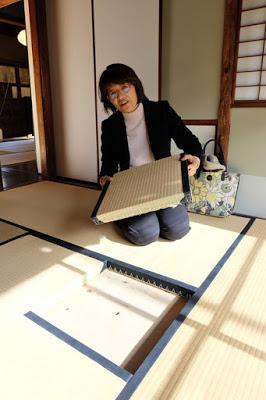 Inside the tea room
Inside the tea roomA few steps dozen steps from Nigiwai-no-ie is Gangoji, a UNESCO world heritage temple, but we don't go in. Instead we move to the southern portion of Naramachi and visit another lattice house, this time a reproduction of a machiya (merchant house) called Koshi-no-ie.
Koshi-no-ie
格子の家
10AM to 5PM, Closed on Mondays
A staff of the machiya shows us a big, plain-looking wooden door. Within that big wooden door (agedo) is a low, small sliding panel (kugurido), where residents of the house pass when the agedo is closed. But how does one open the agedo? It looks heavy! Amazingly, the staff effortlessly swings the agedo inward and upward and lets it hang on a hook so that it remains open.
By the entrance is the mise-no-ma, where the merchant can talk business with his customers. Along the corridor, the staff shows us how to open the high windows with the use of pulleys.
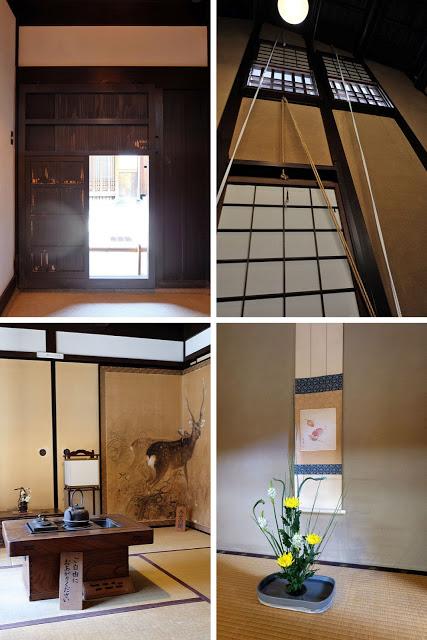 Agedo with the kugurido open (top left), high windows (top right),mise no ma (bottom left), tokonoma (bottom right)
Agedo with the kugurido open (top left), high windows (top right),mise no ma (bottom left), tokonoma (bottom right)The room next to the mise-no-ma, is a tatami room with a hako-kaidan (box staircase), so called because it has drawers and cabinets beneath to save on space. Through the sliding doors is another tatami room with a tokonoma, an alcove with a scroll painting and an ikebana flower arrangement. I take pictures of the tokonoma standing up, and Yoshiko tells me that to appreciate the art in the tokonoma, one has to sit seiza style. I take another photo, this time on my knees, with the scroll eye-level. I scoot to my right and, boom, I see the inner garden.
 Hako-kaidan (left) and the kitchen stove (right)
Hako-kaidan (left) and the kitchen stove (right)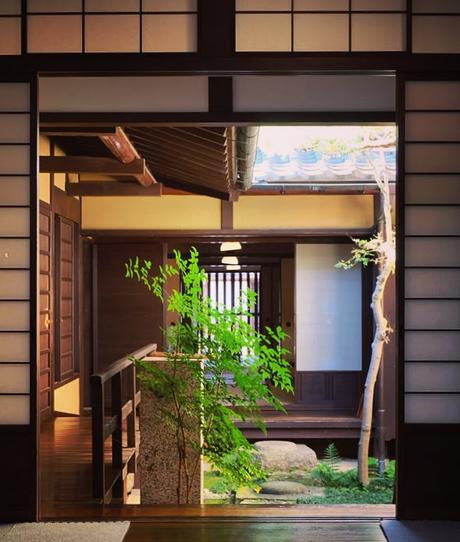 Inner garden
Inner gardenIn the back end of the property is a storage house, a white building separate from the main house. if fire strikes the house, all the treasures in the storage house will be safe. Good thinking.
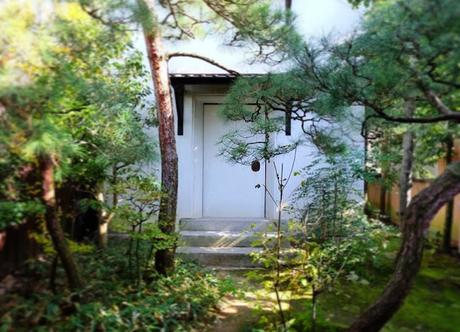 Storage house
Storage houseLike any Japanese town, there are also temples and shrines. We stop by a shrine (Goryo Shrine) and Yoshiko points out the two komainu (lion-dog) standing one on each side of the red torii. One has its mouth open as if it's saying ahhh (a, the first letter in sanskrit) and the other has its mouth closed as if saying um, the last letter in sanskrit. Like alpha and omega, it signifies the beginning and the end.
Inside the shrine, Yoshiko shows me the Shinto way to pray, tells me about omikuji (fortune papers) and why some as tied to a tree, and answers all the random questions I have about Japan's two religions. We take a break in the shrine's gazebo in the center of its small garden, and just enjoy the light breeze and the serenity.
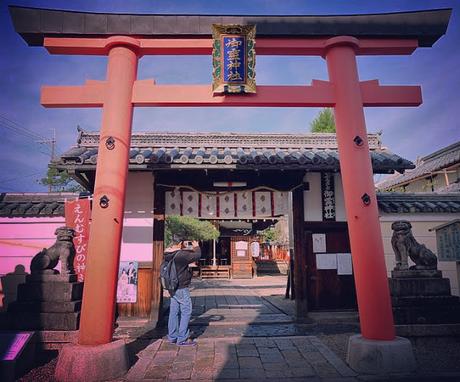 Goryo Shrine
Goryo Shrine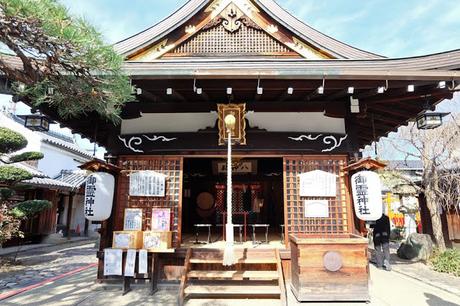
 Omikuji
Omikuji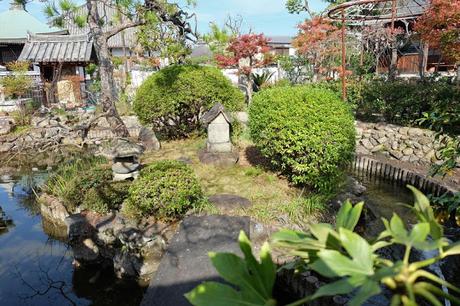 Goryo Shrine's garden in late autumn
Goryo Shrine's garden in late autumnIt is almost the end of our tour, Yoshiko tells me and the Japanese guest. We make our way to the Former Daijoin, our last stop, and to get there we have to cut through Jurin-in Temple. Before doing so, Yoshiko asks me if I don't mind passing through a cemetery. I don't. And we proceed to walk between headstones.
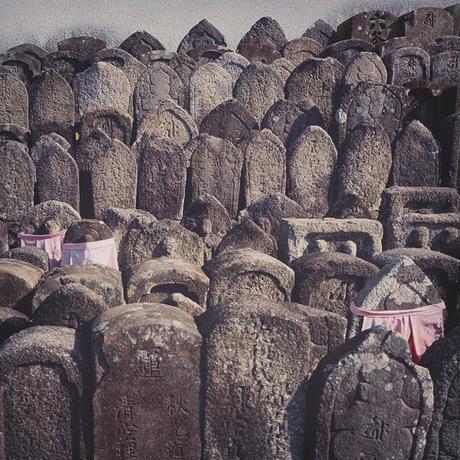 At Jurin-in
At Jurin-inWe end the tour with a view of the garden of the Former Daijoin. There she gives us a rundown of the tour route, tracing it on a map she had produced from her bag.
 Former Daijoin Garden
Former Daijoin GardenShe asks me where I was headed next. I was so hungry, I forgot about going back to Gangoji Temple. All I could think of at the moment was lunch.
Naramachi Walking Tour
Saturdays 10AM to 1PM
See website for tour schedule.
Tour fee: 2000 yen per person
Japan
Know Before You Go
Single Entry Tourist Visa for Japan
Roam Around Japan with a Swagger
An Ignoramus in Japan: Vending Machines
An Ignoramus in Japan: Bathrooms and Toilets
An Ignoramus in Japan: Manhole Covers
I Spy With My Little Eye: Japan's Fashion Contradictions
I Spy With My Little Eye: On the Go in Japan
Kansai Diaries (2016)
9D/9N | Wakayama, Nara, Kyoto, Osaka
UNESCO World Heritage Sites in the Kansai Region
Osaka: Day 0: Arrival
Osaka Accommodations: Hotel Raizan, Hotel Mikado
Wakayama: Day 1: Going to, Sleeping in, and Eating in Koyasan
Wakayama: Day 1.5: West Side of Koya Town
Wakayama: Days 1.75~2: Okunoin, Three Times
Nara: Sleep, Eat, and Explore Nara City
Nara: Day 3: Horyuji, Hokkiji, and some Japanecdotes in Ikaruga Town
Nara: Day 3.5: Yakushiji, Toshodaiji, and Heijo Palace Site in Nara City
Nara: Day 4: Early Morning at Nara Park
Nara: Day 4.25: Naramachi Walking Tour (you're here!)
Kyoto Accommodations: Guesthouse Wind Villa, Shiori Yado
